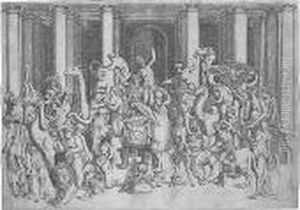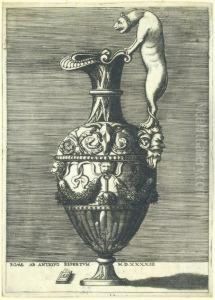Enea Vicus Vico Paintings
Enea Vico, born in 1523 in Parma, Italy, was an Italian engraver and scholar of the Renaissance period. His full name was Enea Vico Vicus, but he is commonly referred to as Enea Vico. Vico demonstrated a talent for the visual arts at an early age, prompting him to pursue a career in engraving, which was a highly respected and innovative art form during the 16th century.
Vico initially trained under the tutelage of Parmigianino, an Italian Mannerist painter and etcher, which significantly influenced his style and technique. His early works were characterized by their intricate detail and the influence of Mannerist elegance. After Parmigianino's death, Vico continued his studies in Rome, where he was exposed to the works of ancient Roman art and the Renaissance masters. This exposure further developed his engraving style, which began to incorporate elements of classical art and architecture.
Throughout his career, Vico became known for his engravings of ancient Roman sculptures and reliefs, as well as his reproductions of contemporary Renaissance artworks. He was also an antiquarian and had a keen interest in numismatics, the study of coins and medals, which he incorporated into his work. Vico produced a significant corpus of engravings that were collected and studied by artists and scholars throughout Europe, contributing to the spread of classical styles and motifs.
Vico's contributions to the field of engraving were recognized by his contemporaries, and he enjoyed the patronage of several important figures of the time, including the Medici family in Florence. His work as an engraver not only reflected the artistic trends of the Renaissance but also played a role in the dissemination of knowledge about ancient art and artifacts.
Enea Vico died in 1567, leaving behind a legacy as one of the prominent engravers of the Renaissance. His works continue to be appreciated for their technical skill and historical significance, offering insights into the Renaissance's fascination with classical antiquity.



